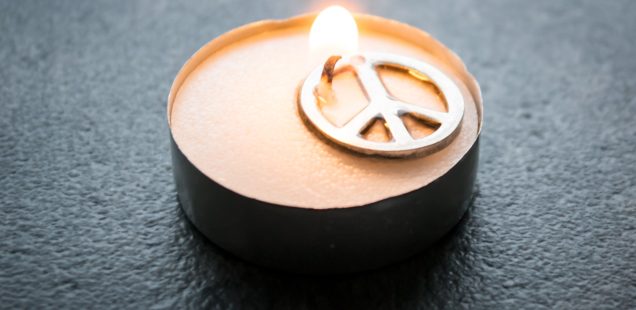
Contemplating candlelight
Vid det nordiska kväkarmötet i Stavanger i början av juli deltog även gäster från andra kväkarmöten i Europa. En av dem var Denis Stewart från Nordirland. Han har senare skickat en text, ”Contemplating candlelight”, där han berättar om några upplevelser han hade i Norge under de där dagarna, och om vad ett ljus kan betyda.
”On a Sunday morning a few weeks ago, my travelling companion and I had occasion to sit for an hour in a Quaker gathering in the south-west Norwegian city of Stavanger. The gathering was what members of the Religious Society of Friends refer to as ‘meeting for worship’.
The room in which we sat in ‘gathered stillness’ was simply furnished, with chairs placed in a rectangular u-shape around a low table. On the table were a few books and, placed in the centre, a lit candle. A sizeable window adjacent to the open side of the u-arrangement looked out to part of a harbour where a Norwegian naval vessel, a warship of some sort, was moored.
So here we were, a small group, sitting in a peaceful, quietly contemplative space. We had cause to be grateful for the freedom to be together in security and tranquil silence. And, at the same time, the visible proximity of weapons of wars beyond the window was a stark reminder of the horrific insecurity and devastation afflicting many of our human kin in other parts of the world beyond our window – a world that feels like an increasingly darkened and troubled place.
I found myself thinking about the candle. How it’s flame was a source of light and warmth. How its flame will flicker in a breeze, and is fragile. How lighting a candle is a small act of practical hope, signifying the expression of commitment to creating illumination in the context of deep and dominating darkness.
And I recalled a visit to the Nobel Peace Centre in Oslo a few days previously. For me, an especially memorable part of the Peace Centre exhibition was the display, in a darkened room, of illuminated images of the women, men and several organisations that had been recipients of the annual Peace Award since its inception in 1901. Among these were the faces of four of my compatriots from Northern Ireland – first Mairead Corrigan and Betty Williams (1976); then John Hume and David Trimble (1998). Any sense of pride by association I was feeling as I looked at these images – and heard, elsewhere in the Centre, recordings of their variously Northern Irish voices – was tempered by sadness and some anger. Sadness that the efforts of these Nobel Peace Laureates had been necessitated by the euphemistically named ‘Troubles’ in Northern Ireland. And anger at the callous stupidity, the tragic absurdity and painful pointlessness of the decades of destructive and murderous violence. During those decades there had been plenty of cause to rail against the darkness. And, to this day, there are not a few who have suffered terrible loss and who continue, understandably, to rail and grieve.
Reflecting on the contributions made by the two pairs of Northern Irish recipients of the Nobel Peace Prize to a ‘cease process’ that helped to make space for a peaceful settlement, an early 21 st century re-interpretation of an ancient Chinese proverb came to mind: Don’t get stuck critiquing the darkness. Light a candle. So there is cause to be grateful to these fourfolk who, along with many other courageous souls, did not get stuck raging against the darkness of their times and circumstances.
As my contemplation of candlelight continued in the gathered stillness of that room in Stavanger, and with Alfred Nobel’s wider legacy in mind, my thoughts turned, not for the first time, to powerful words spoken by another Northern Irish person, a poet of considerable renown, at home and abroad. In December 1995, Seamus Heaney, wordsmith from the village of Bellaghy in Co Derry, addressed an audience in the Swedish Academy in Stockholm on the occasion of his being awarded the Nobel Prize for Literature. As he mused on the murderous context within which he had lived and moved for several decades, Heaney said: I began ..to try to make space in my reckoning and imagining for the marvellous as well as for the murderous.
These words speak to us today – we who are often feeling anxious and pressed down in the face of fearful events in the worlds we inhabit, and overwhelmed by the destructively powerful times in which we live. We too need to make and preserve space for being appreciatively attentive to the marvellous, even in the midst of contending with the murderous. And, moreover, we have, from the light within us, the power to add to the marvellous by lighting and tending to a candle.”

